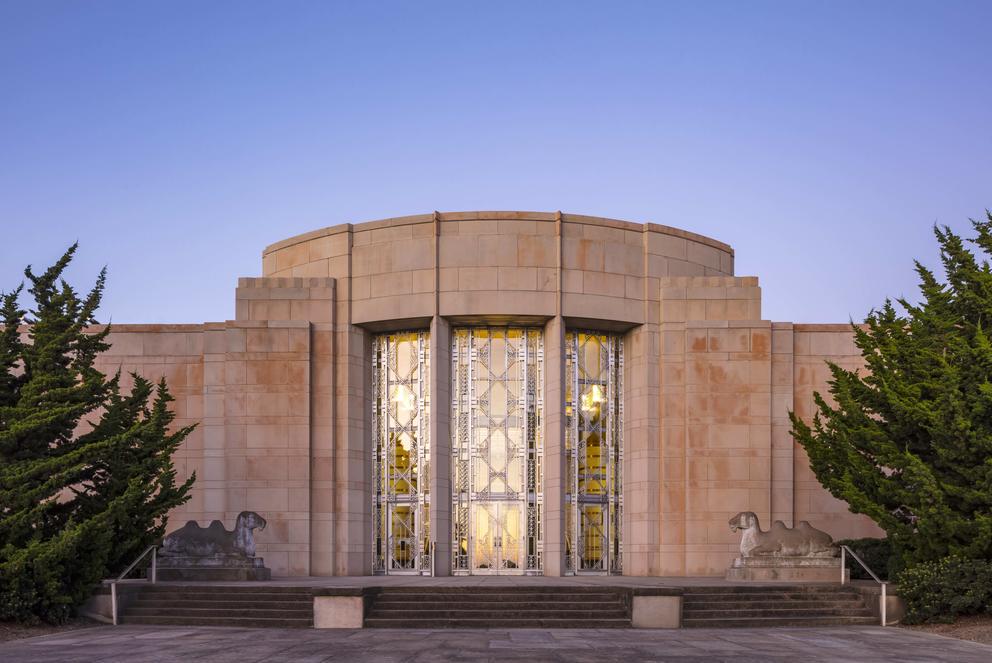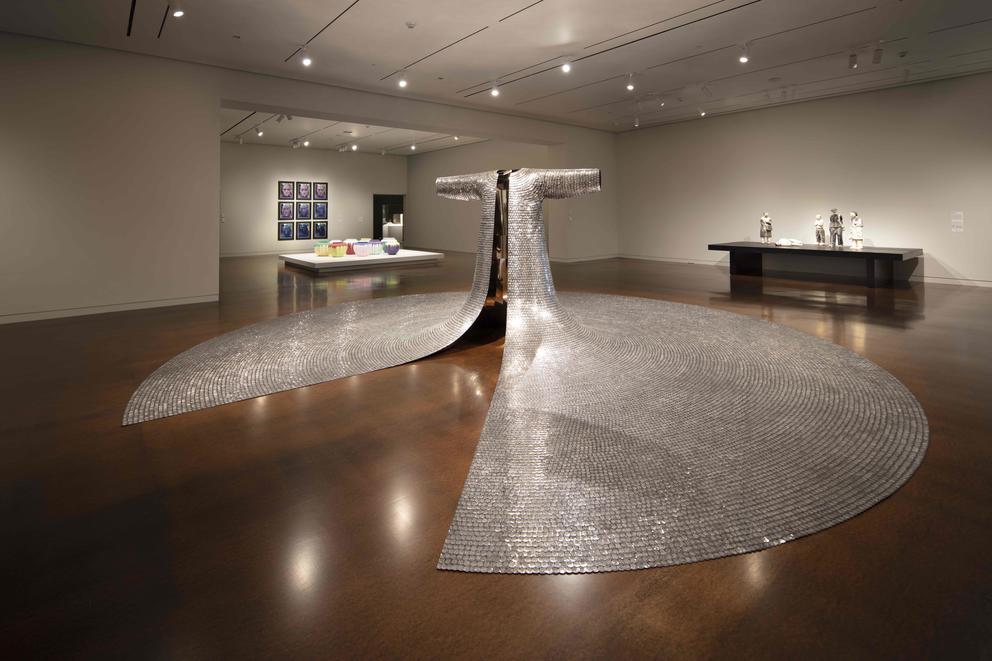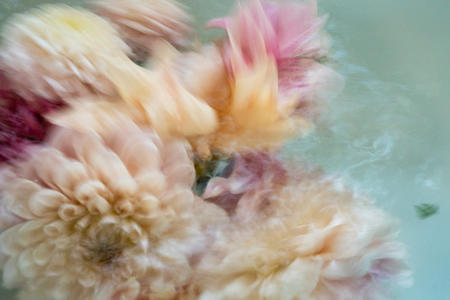Small pieces of paper with miniature images of the absent art indicated what was gone: a delicate, 13th century scroll from Japan; a 400-plus-year-old ink-and-gold watercolor from India; a Mughal dynasty era folio depicting the art of falconry.
Thankfully, it wasn’t a heist. These artworks will settle back into their assigned spots among the other sculptures, scrolls, robes, paintings and photographs when the Volunteer Park museum reopens in May after a yearlong COVID closure.
It’s the second reopening for SAAM in just over a year. After being closed for a three-year renovation, the museum reopened to great fanfare during a sold-out weekend in February of 2020. The refreshed rooms contained works from 2500 BCE to the present day, representing the various countries, dynasties and cultures across Asia: China, Korea, Japan, India, the Himalayas, West, Central and Southeast Asia (though the collection skews heaviest toward Chinese and Japanese). But after just 35 days, as the coronavirus spread across the world, museum staff shuttered the grand aluminum gates once more, turning off the lights on the way out.
Despite the locked doors and darkened, desolate galleries, some ambient and low-level light continued trickling in. Nick Dorman, Seattle Art Museum’s Jane Lang Davis Chief Conservator, and his team worried about light degradation — which can permanently damage fragile (mostly paper) artworks and which is why these pieces are rotated every six months. So they covered up light-sensitive paintings and sculptures with dark pieces of cloth, cloaking them like birdcages.
At the time, this stopgap solution seemed the most sensible. “We all thought we'd be closed for a little while. Nobody thought we'd be shut for a year and change,” Dorman tells me on a recent walk-through of the museum. But as the pandemic wore on, his team decided to remove fragile and light-sensitive works from the walls and move them to the belly of Seattle Art Museum’s storage space, just to be safe.
During the past year, his team would regularly pay visits to the low-lit and echoey museum to check on the state of the art left in the galleries. “It was pretty quiet,” Dorman says. “It was us and the security guards — kind of nice.”
The quiet picture he paints — and the calm of our visit — stands in stark contrast to the hubbub of the tens of thousands of visitors shuffling through the museum halls back in February. Crowds like that are a no-go in COVID times. (Unlike the Seattle Art Museum’s downtown digs and other museums across the region, the museum chose not to reopen during the few months when it was permitted this past fall.)
When the museum re-reopens on May 28, it will have a lower maximum capacity and one-way traffic, says Xiaojin Wu, SAM’s Atsuhiko & Ina Goodwin Tateuchi Foundation curator of Japanese and Korean Art. Her voice betrays a slight disappointment about the loss of freedom to explore and sense of discovery. “The beauty of this building is that it was designed for multiple access points,” she says. “That was what was special about the space.”
Wu leads us to one of the museum’s smaller, windowless rooms, with charcoal-colored walls. A wide pedestal snakes around the room and supports three spotlighted Buddha sculptures: a 12th century seated “Amida Buddha” from Japan, a wood-and-gold-lacquered figure from Heian period (794-1185) Japan and a sandstone “awakened one” hailing from Thailand. Together, they form a welcoming semicircle in the shadowed gallery.
“We had a bench here before,” Wu explains, bending her knees as if seating herself on an invisible chair. “When the visitor sits here, their eyes would meet the ‘Amida Buddha’s’ downward gaze right there,” she says, pointing at the Buddha’s eyes. “A one-on-one experience, very unique,” she says.
For safety reasons, the bench won’t return for the reopening. “But we hope people still get that point where you're supposed to have a quiet moment to look at the artworks around you.”
One such artwork that visitors might find particularly apropos is “Rakuchu rakugai zu (Scenes in and around the Capital),” an effervescent six-panel folding screen, painted by an anonymous Japanese master in the 17th century. A retreating, gold-leafed cloud cover reveals a world teeming with life: fluffy emerald treetops, a flowing navy blue river, bridges and pagodas and, in between it all, crowds of people united in festivities and traditional festivals. Foong Ping, SAM’s Foster Foundation curator of Chinese art, points to the central part of the right screen, which depicts a parade celebrating Kyoto’s most important festival: Gion Matsuri.
“A festival which celebrated the end of a plague,” Foong says. “We can use a painting like this right now.”
Gion Matsuri started as a religious ceremony to appease the gods during an epidemic in 869 and has been celebrated every July in Kyoto to this day. Looking at the scene with a contemporary (and COVID-colored) lens, these tiny figures seem to have a spring in their step, as if they’re emerging from a darker place.
The artwork itself — part of SAAM’s permanent collection — had been sequestered in darkness for years, too. The paint was flaking and the panels had turned brittle, rendering the work unfit to be shown or lent to other museums. The reopening of SAAM in early 2020 was supposed to be its grand reintroduction to the audience after an extensive restoration.
Before 2020, the museum had been in the same boat. Built in the 1930s, the building was badly in need of an extensive facelift and upgrade. Local firm LMN Architects took on the $56 million renovation that expanded the building’s footprint while bringing in more light, thanks to an impressive, glass-enclosed addition that looks out onto Volunteer Park. To Foong and Wu, the overhaul proved a chance to rethink the permanent collection from scratch, too. They decided to group the artworks thematically and cross-culturally rather than chronologically or geographically — an unusual choice designed to create a more lively experience and showcase shared bonds across cultures, time and place.
To demonstrate the magic these new connections can create, Wu walks us to another dimly lit gallery, this one filled with delicate paper scrolls and book folios dedicated to the holy word. In one display case, two pieces of priceless paper seem to have been drenched in the night sky. A folio from the famous 9th century “Blue Qur’an” (Tunisia) features gold and silver script on indigo-dyed parchment. Next to it, the golden and silver words of the Lotus Sutra appear on indigo-dyed paper, a handscroll dating back to the 12th century (Japan). On the surface, the two are linked by the shimmer of gold and tempestuous blue, but together they also suggest a power beyond words.
Though sparsely, there are also “younger” artworks sprinkled throughout the museum, such as photos by contemporary artists Jung Yeondoo and Anita Dube, which peer over ancient vessels, sculptures and paper scrolls from their perches on the wall.
Also new since the renovation: a gallery dedicated to special exhibitions — the current show, “Be/Longing” showcases contemporary Asian art. (Just like the older pieces on view, works included here will be switched out every six months. Next installment: July.) An assortment of brightly splashed pots from Ai Wei Wei, the captivating gaze of a man in a glimmering painting by Jitish Kallat and a group of clay figures by Akio Takamori catch the eye, but the show stealer is a shiny, open-armed but imposing ceremonial robe/armored suit.
Contemporary Korean artist Do Ho Suh painstakingly assembled the sculpture from 100,000 stainless steel military dog tags to commemorate his time in the South Korean military — piecing together what it means to be part of a whole but also never quite made to feel wholly human, in the military and as an immigrant to the U.S.
“This was our ‘Mona Lisa,’ ” Wu says. “Everybody came here to see the Do Ho Suh sculpture.” She rounds the corner to what she says is one of her favorite works: “Mandala: Zone of Zero.” Korean-born artist Kimsooja repurposed jukebox parts to create the three dazzling, circular bubbler speakers in the multimedia installation named after an ideal, enlightened state.
“She uses these kitsch commercial jukeboxes to stand in for the mandala,” says Wu. No need to drop a quarter in or press play. The spinning wheels automatically emit echoing chants from various religious traditions — Islamic, Gregorian and Tibetan Buddhist — each contributing unique lines to the divine dissonance.
It’s an apt metaphor for the curators’ vision for the museum’s new approach to bringing together cultures and traditions across time and place.
“You [can] hear each soundtrack at different levels at different times,” Wu says of the music filling the room like an interfaith chorus. “But at one point, they all kind of merge.”













